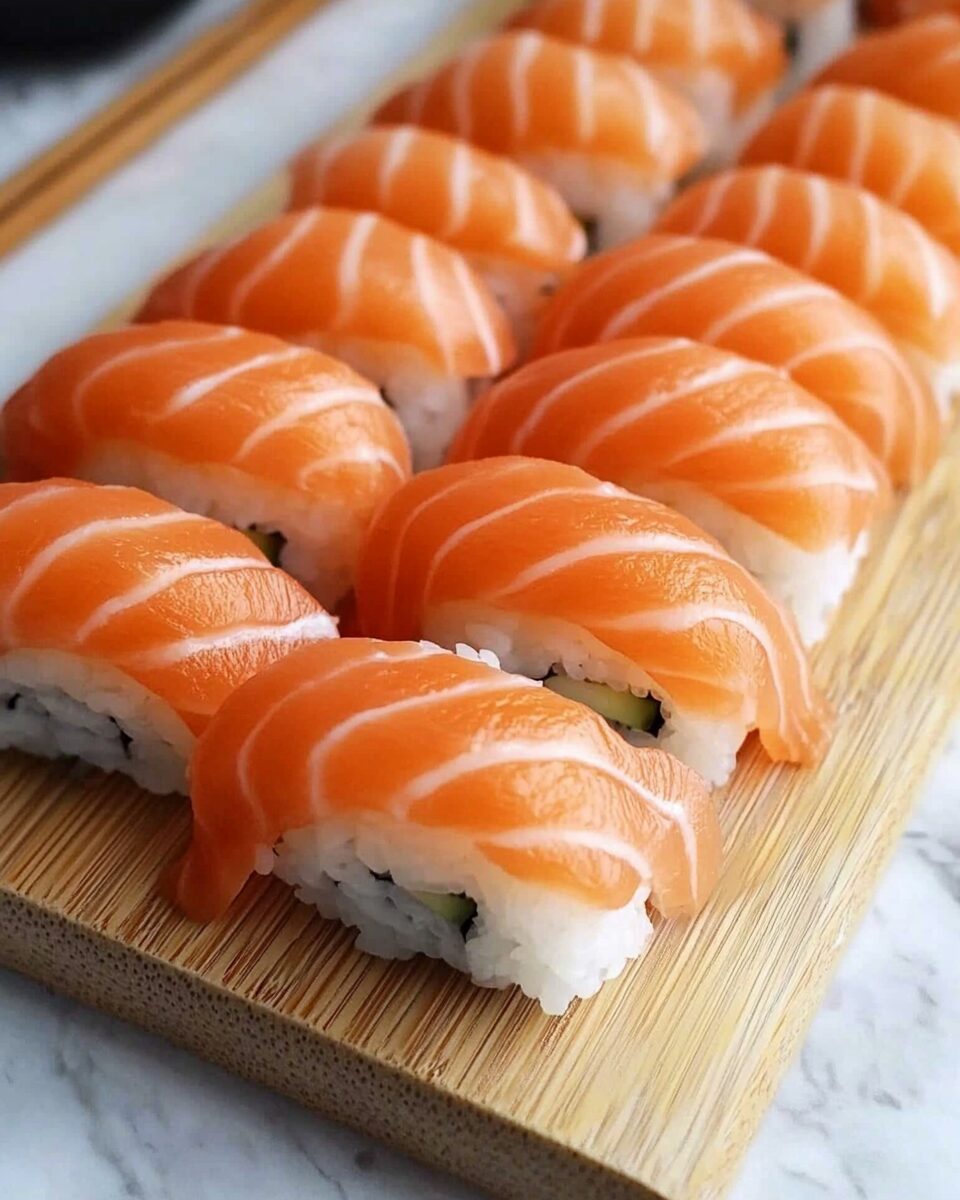Salmon Nigiri is one of the most beloved sushi dishes, featuring delicate slices of sushi-grade salmon placed over perfectly seasoned rice. This simple yet elegant Japanese dish highlights the fresh flavors of salmon, complemented by the subtle tang of rice vinegar and a touch of wasabi for heat.
Making your own Salmon Nigiri at home allows you to experience the beauty of hand-pressed sushi with high-quality ingredients. Whether you’re hosting a sushi night or simply treating yourself, this dish is a great way to explore Japanese cuisine in a fresh, homemade way. Pair it with soy sauce, pickled ginger, and a side of miso soup for a complete sushi experience.
Full Recipe
Ingredients:
- 200g sushi-grade salmon, thinly sliced
- 2 cups sushi rice, cooked and seasoned
- 2 tbsp rice vinegar
- 1 tbsp sugar
- ½ tsp salt
- 1 sheet nori, cut into thin strips (optional)
- Wasabi, to taste
- Soy sauce, for serving
- Pickled ginger, for garnish
Directions:
- Cook sushi rice according to package instructions, then season with rice vinegar, sugar, and salt while still warm. Let it cool to room temperature.
- Dampen your hands with water to prevent sticking, then take a small handful of rice (about 20g) and shape it into an oval.
- Place a thin slice of salmon over the rice and gently press it down to secure.
- If using nori, wrap a thin strip around the middle to hold the fish in place.
- Add a small amount of wasabi between the rice and salmon if desired.
- Serve immediately with soy sauce, wasabi, and pickled ginger.
Prep Time: 10 minutes | Total Time: 10 minutes
Kcal: 120 kcal per piece | Servings: 10 pieces
Salmon Nigiri: A Classic Japanese Delight
Salmon Nigiri is a staple of Japanese cuisine, combining fresh, high-quality salmon with seasoned sushi rice. This elegant dish is a favorite among sushi lovers for its simple yet refined flavors. The contrast between the tender, buttery salmon and the slightly tangy rice makes for a perfect bite every time. Whether you’re a sushi enthusiast or new to homemade sushi, learning how to make Salmon Nigiri will elevate your culinary skills and impress your guests.
The Origin of Nigiri Sushi
Nigiri sushi originated in Japan during the Edo period (1603–1868) as a form of fast food. Unlike traditional sushi, which was originally fermented fish with rice, nigiri evolved into a fresh, hand-pressed style that allowed for immediate consumption. The technique of forming a small mound of rice and topping it with fresh fish was developed in Tokyo, and it quickly became a popular choice for sushi lovers. Today, nigiri remains a centerpiece of sushi culture, served in high-end restaurants and casual eateries alike.
Why Salmon Nigiri is So Popular
Salmon Nigiri is one of the most beloved types of sushi worldwide. There are several reasons for its popularity:
- Mild, Buttery Flavor – Unlike some other types of raw fish used in sushi, salmon has a mild, slightly sweet taste that pairs beautifully with the tangy sushi rice.
- Smooth, Tender Texture – High-quality, sushi-grade salmon is soft and delicate, making it easy to eat and enjoyable for both beginners and experienced sushi lovers.
- Nutritional Benefits – Salmon is rich in omega-3 fatty acids, which are essential for heart health, brain function, and overall well-being.
- Versatility – Salmon Nigiri can be enjoyed on its own, drizzled with a bit of soy sauce, or topped with garnishes like thinly sliced green onions, sesame seeds, or a touch of wasabi.
The Importance of Sushi-Grade Salmon
One of the most important factors in making Salmon Nigiri is using sushi-grade salmon. Unlike regular salmon that you might buy for cooking, sushi-grade salmon has been frozen at very low temperatures to kill any parasites and ensure its safety for raw consumption. When purchasing salmon for nigiri, always look for labels that indicate it is safe for sushi, or buy from a reputable fish market that specializes in sushi-grade seafood.
The Role of Sushi Rice in Nigiri
While the salmon is the star of the dish, sushi rice plays an equally crucial role in creating the perfect bite. Sushi rice, also known as shari or sumeshi, is short-grain rice seasoned with rice vinegar, sugar, and salt. The seasoning enhances the rice’s natural sweetness and complements the rich flavor of the salmon.
The texture of sushi rice is also key—it should be sticky enough to hold its shape but not so dense that it becomes heavy. Proper preparation of sushi rice involves washing the grains thoroughly to remove excess starch, cooking them to the perfect consistency, and seasoning them while they are still warm.
How to Shape the Perfect Nigiri
Shaping nigiri requires a bit of technique and practice, but once you get the hang of it, it becomes second nature. The key steps include:
- Wetting your hands slightly to prevent the rice from sticking.
- Taking a small portion of sushi rice and gently forming it into an oval shape.
- Placing the salmon slice over the rice and pressing lightly to secure it.
Some sushi chefs also add a small dab of wasabi between the rice and the fish to enhance the flavor. While optional, this step adds an authentic touch to the dish.
Garnishing and Serving Suggestions
Salmon Nigiri can be enjoyed as is, but adding simple garnishes can elevate the dish. Some popular options include:
- A light brush of soy sauce – Instead of dipping the nigiri directly into soy sauce, which can make the rice fall apart, some chefs brush a small amount on top of the salmon.
- A sprinkle of sesame seeds – Toasted sesame seeds add a subtle nuttiness and a bit of texture.
- Thinly sliced green onions – These add a fresh, mild onion flavor that complements the salmon.
- A small dollop of wasabi or spicy mayo – For those who like a bit of heat, adding a tiny amount of wasabi or a drizzle of spicy mayo enhances the taste.
Pairing Salmon Nigiri with Other Sushi Dishes
If you’re making Salmon Nigiri at home, consider pairing it with other sushi dishes to create a full sushi experience:
- Miso Soup – A warm and comforting way to start a sushi meal.
- Edamame – Lightly salted, steamed soybeans make a great appetizer.
- Seaweed Salad – A refreshing side with a slightly tangy and umami-rich flavor.
- Sushi Rolls – Try making simple sushi rolls, such as California rolls or cucumber rolls, to complement the nigiri.
Tips for Making Restaurant-Quality Salmon Nigiri at Home
Making nigiri at home can seem intimidating at first, but with the right techniques and ingredients, you can achieve restaurant-quality results. Here are some expert tips:
- Use a sharp knife – A dull knife can tear the salmon instead of creating clean, smooth slices. A long, sharp sushi knife is ideal for cutting fish.
- Don’t overwork the rice – Handling the rice too much can make it too dense. Lightly shape it with minimal pressure.
- Keep your hands moist – Dipping your fingers in water prevents the rice from sticking and makes shaping easier.
- Use the freshest fish possible – The quality of the salmon is the most important factor in the final taste of your nigiri.
Common Mistakes to Avoid
When making Salmon Nigiri, there are a few common mistakes that can affect the final dish:
- Using warm fish – Sushi-grade salmon should be slightly chilled but not frozen. This ensures the best texture and flavor.
- Over-seasoning the rice – Too much vinegar or sugar can overpower the natural taste of the salmon.
- Pressing too hard on the rice – This can make the nigiri too firm and difficult to eat.
Is Salmon Nigiri Safe to Eat Raw?
One of the most common concerns people have about eating Salmon Nigiri is whether it is safe to eat raw fish. When made with sushi-grade salmon, the dish is completely safe, as the fish has been properly handled and frozen to eliminate any potential parasites. However, it is always best to purchase salmon from a trusted source and store it properly until ready to use.
Conclusion
Salmon Nigiri is a timeless and elegant dish that showcases the beauty of Japanese sushi-making. With its delicate balance of flavors and textures, it remains a favorite among sushi lovers worldwide. Whether you’re looking to recreate an authentic sushi experience at home or simply enjoy a healthy and delicious meal, mastering the art of Salmon Nigiri is a rewarding skill.
By using high-quality sushi-grade salmon, perfectly seasoned rice, and practicing proper nigiri-shaping techniques, you can create a restaurant-quality dish that will impress family and friends. Pair it with classic Japanese sides, experiment with garnishes, and enjoy the simplicity and elegance of this traditional sushi favorite.






